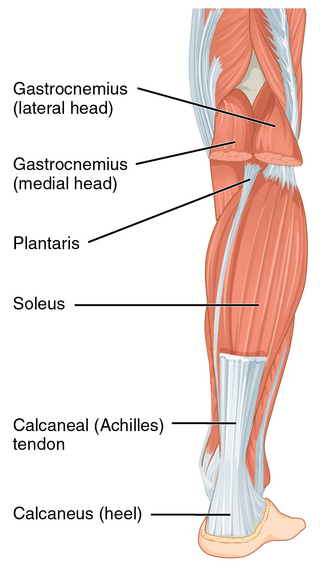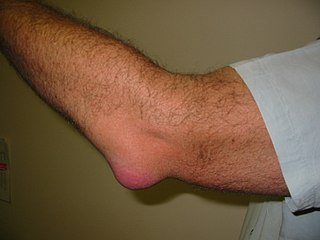Related Research Articles

A bunion, also known as hallux valgus, is a deformity of the MTP joint connecting the big toe to the foot. The big toe often bends towards the other toes and the joint becomes red and painful. The onset of bunions is typically gradual. Complications may include bursitis or arthritis.

Tenosynovitis is the inflammation of the fluid-filled sheath that surrounds a tendon, typically leading to joint pain, swelling, and stiffness. Tenosynovitis can be either infectious or noninfectious. Common clinical manifestations of noninfectious tenosynovitis include de Quervain tendinopathy and stenosing tenosynovitis.

Shoulder problems including pain, are one of the more common reasons for physician visits for musculoskeletal symptoms. The shoulder is the most movable joint in the body. However, it is an unstable joint because of the range of motion allowed. This instability increases the likelihood of joint injury, often leading to a degenerative process in which tissues break down and no longer function well.

The Achilles tendon or heel cord, also known as the calcaneal tendon, is a tendon at the back of the lower leg, and is the thickest in the human body. It serves to attach the plantaris, gastrocnemius (calf) and soleus muscles to the calcaneus (heel) bone. These muscles, acting via the tendon, cause plantar flexion of the foot at the ankle joint, and flexion at the knee.

Bursitis is the inflammation of one or more bursae of synovial fluid in the body. They are lined with a synovial membrane that secretes a lubricating synovial fluid. There are more than 150 bursae in the human body. The bursae rest at the points where internal functionaries, such as muscles and tendons, slide across bone. Healthy bursae create a smooth, almost frictionless functional gliding surface making normal movement painless. When bursitis occurs, however, movement relying on the inflamed bursa becomes difficult and painful. Moreover, movement of tendons and muscles over the inflamed bursa aggravates its inflammation, perpetuating the problem. Muscle can also be stiffened.

Plantar fasciitis or plantar heel pain is a disorder of the plantar fascia, which is the connective tissue that supports the arch of the foot. It results in pain in the heel and bottom of the foot that is usually most severe with the first steps of the day or following a period of rest. Pain is also frequently brought on by bending the foot and toes up towards the shin. The pain typically comes on gradually, and it affects both feet in about one-third of cases.

Achilles tendinitis, also known as Achilles tendinopathy, is soreness the Achilles tendon. It is accompanied by alterations in the tendon's structure and mechanical properties. The most common symptoms are pain and swelling around the back of the ankle. The pain is typically worse at the start of exercise and decreases thereafter. Stiffness of the ankle may also be present. Onset is generally gradual.

Achilles tendon rupture is when the Achilles tendon, at the back of the ankle, breaks. Symptoms include the sudden onset of sharp pain in the heel. A snapping sound may be heard as the tendon breaks and walking becomes difficult.

Knee effusion, informally known as water on the knee, occurs when excess synovial fluid accumulates in or around the knee joint. It has many common causes, including arthritis, injury to the ligaments or meniscus, or fluid collecting in the bursa, a condition known as prepatellar bursitis.

Enthesitis is inflammation of the entheses, the sites where tendons, ligaments and joint capsules attach to bones.
Greater trochanteric pain syndrome (GTPS), a form of bursitis, is inflammation of the trochanteric bursa, a part of the hip.

Olecranon bursitis is a condition characterized by swelling, redness, and pain at the tip of the elbow. If the underlying cause is due to an infection, fever may be present. The condition is relatively common and is one of the most frequent types of bursitis.

Subacromial bursitis is a condition caused by inflammation of the bursa that separates the superior surface of the supraspinatus tendon from the overlying coraco-acromial ligament, acromion, and coracoid and from the deep surface of the deltoid muscle. The subacromial bursa helps the motion of the supraspinatus tendon of the rotator cuff in activities such as overhead work.
Pes anserinus refers to the conjoined tendons of three muscles of the thigh. Pes means 'foot' in Latin. In Latin, anser means 'goose', and anserinus means 'goose-like'.
Shoulder surgery is a means of treating injured shoulders. Many surgeries have been developed to repair the muscles, connective tissue, or damaged joints that can arise from traumatic or overuse injuries to the shoulder.

Pes anserine bursitis is an inflammatory condition of the medial (inner) knee at the anserine bursa, a sub muscular bursa, just below the pes anserinus.

Knee pain is pain in or around the knee.

Calcific bursitis refers to calcium deposits within the bursae. This most occurs in the shoulder area. The most common bursa for calcific bursitis to occur is the subacromial bursa. A bursa is a small, fluid-filled sac that reduces friction, and facilitates movements between its adjacent tissues. Inflammation of the bursae is called bursitis.
Achilles bursitis is bursitis of bursa situated above the insertion of tendon to calcaneus. It results from overuse and wearing of tight shoes.
Haglund's syndrome is a group of signs and symptoms consisting of Haglund's deformity in combination with retrocalcaneal bursitis. It is often accompanied by Achilles tendinitis.
References
- ↑ Fauci, Anthony (2010). Harrison's Rheumatology, Second Edition. McGraw-Hill Professional Publishing; Digital Edition. p. 271. ISBN 9780071741460.
- ↑ DPM, Jesse Burks. "Heel Bursitis Causes and Risk Factors". Arthritis-health. Retrieved 2022-09-02.